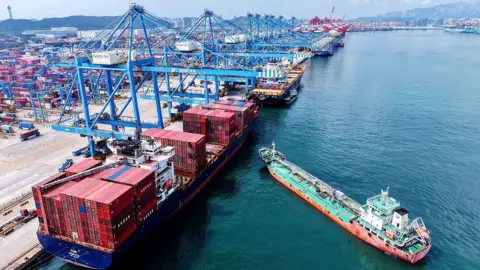In a significant development that has captured global economic attention, the United States and China have mutually agreed to extend their trade truce, pushing the expiration date to November 10, 2025. This decision came as both nations sought to avert an imminent increase in tariffs that had been initially scheduled to take effect shortly.
The announcement was encapsulated in a joint statement from the two leading economies, which noted that the higher tariffs on goods traded between the countries, disclosed earlier in the year, will remain suspended for an additional 90 days. This extension is pivotal as it was just a matter of hours away from escalating into a new wave of tariff increases that could have further strained trade relations.
During recent discussions, both nations characterized their dialogue as “constructive.” China’s lead negotiator indicated they were keen on preserving the truce. Meanwhile, US officials awaited the final approval from President Donald Trump, who ended up supporting the extension of the arrangement via a post on his Truth Social platform. In his update, Trump confirmed that he had signed an executive order to prolong the tariff suspension while maintaining all other components of the existing trade agreement.
The extension has been portrayed as an opportunity for more in-depth negotiations surrounding critical issues like trade imbalances and unfair trading practices. As stated by the White House, both sides will also explore ways to enhance access for US exporters to Chinese markets and tackle various national security and economic challenges.
The potential imposition of higher tariffs posed serious risks for both countries, including trade turmoil and fluctuations in prices and the broader economy. Concerns grew particularly acute earlier in April as tensions escalated, triggered largely by Trump’s announcement of extensive tariffs on foreign goods, with China bearing some of the most significant levies.
In retaliation, Beijing brought forward its own set of tariffs, generating a cyclical conflict that resulted in substantial tariff rates on both sides, nearly crippling trade interactions. Fortunately, in May, both nations consented to suspend some of these measures, albeit under conditions that still left significant tariffs in place: 30% on Chinese imports to the US and 10% on US exports to China.
Currently, the dialogue between these two economic giants encompasses a variety of contentious issues, such as China’s access to rare earth materials, its continued purchases of oil from Russia, and US restrictions on advanced technology exports to China, which notably includes semiconductor chips. Notably, recent adjustments by the Trump administration have seen the relaxing of certain export constraints, allowing major companies like AMD and Nvidia to resume their sales of specific chips to Chinese entities—conditional on sharing portions of their revenues with the US government.
Additionally, the US government actively advocates for the divestiture of TikTok from its current Chinese parent company, ByteDance, a move that faces staunch opposition from Beijing. Despite the positive developments of the truce extension, trade volumes between the two countries have notably diminished this year. Reports indicate that US imports of Chinese goods fell sharply, down nearly 50% in June compared to the same month in 2024.
The first half of 2025 witnessed a significant drop in US imports from China, with the figure totaling approximately $165 billion (£130 billion), marking a 15% decline compared to the previous year. Concurrently, American exports to China have dwindled by around 20% during the same period, underscoring the tense economic climate and the potential overarching challenges facing both nations as they continue to negotiate the nuances of their trade relations.
In summary, the extension of the tariff truce between the United States and China is a critical move aimed at not only staving off immediate trade conflict but also facilitating further discussions necessary for resolving longstanding economic tensions, which have implications that resonate far beyond their bilateral relations, impacting the global economy at large.











